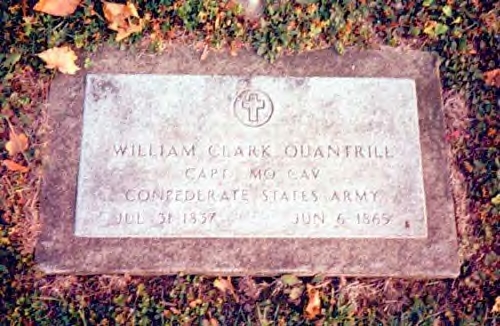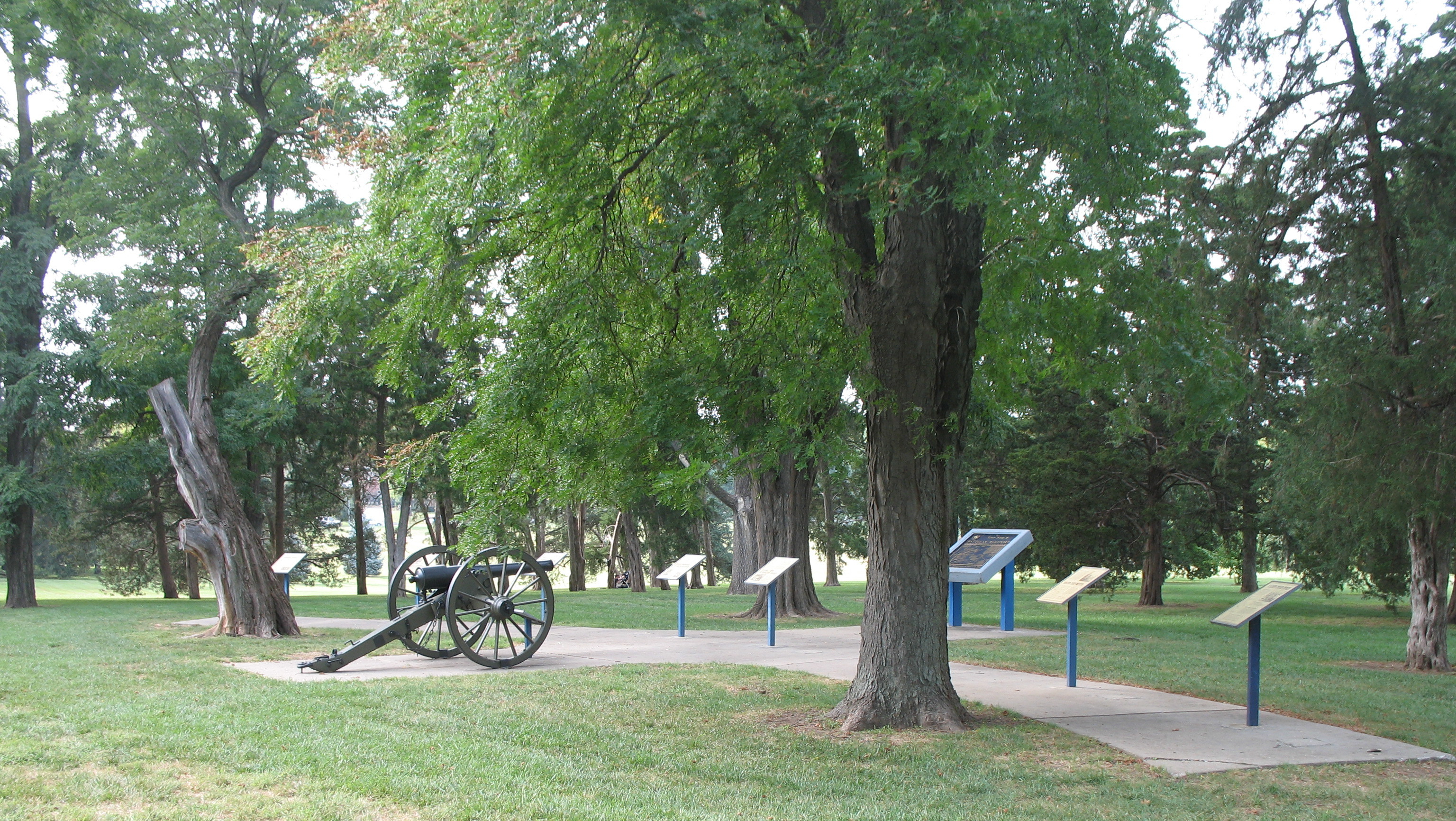|
Mount Oread Civil War Posts
Lawrence, Kansas was not well defended in the early part of the Civil War. That ended with William Quantrill's devastating guerrilla raid August 21, 1863. By early 1864 Union soldiers were permanently camped on the top and slopes of Mount Oread, then to Lawrence's southwest. It seems the camp was originally named Camp Ewing, after Brig. Gen. Thomas Ewing. Soon a battery of cannon was placed on the top of Mount Oread and in July 1864 construction began on Fort Ulysses, also on Mount Oread. The citizens of Lawrence helped in the fort's construction. Its date of completion is unknown, although it was still under construction in December. It is very possible it was never finished. The advance of Confederate Maj. Gen. Sterling Price in Missouri in October 1864 brought an urgency to efforts to protect Lawrence. The town was placed under martial law and a large guard detail protected the town each night. On October 18 the provost marshal at Lawrence decreed all businesses in Lawren ... [...More Info...] [...Related Items...] OR: [Wikipedia] [Google] [Baidu] |
Lawrence, Kansas
Lawrence is the county seat of Douglas County, Kansas, Douglas County, Kansas, United States, and the sixth-largest city in the state. It is in the northeastern sector of the state, astride Interstate 70, between the Kansas River, Kansas and Wakarusa River, Wakarusa Rivers. As of the 2020 United States census, 2020 census, the population of the city was 94,934. Lawrence is a college town and the home to both the University of Kansas and Haskell Indian Nations University. Lawrence was founded by the New England Emigrant Aid Company (NEEAC) and was named for Amos A. Lawrence, an abolitionist from Massachusetts, who offered financial aid and support for the settlement. Lawrence was central to the "Bleeding Kansas" period (1854–1861), and the site of the Wakarusa War (1855) and the Sacking of Lawrence (1856). During the American Civil War it was also the site of the Lawrence massacre (1863). Lawrence began as a center of Free-Stater (Kansas), free-state politics. Its economy diver ... [...More Info...] [...Related Items...] OR: [Wikipedia] [Google] [Baidu] |
William Quantrill
William Clarke Quantrill (July 31, 1837 – June 6, 1865) was a Confederate guerrilla leader during the American Civil War. Having endured a tempestuous childhood before later becoming a schoolteacher, Quantrill joined a group of bandits who roamed the Missouri and Kansas countryside to apprehend escaped slaves. Later, the group became Confederate soldiers, who were referred to as "Quantrill's Raiders". It was a pro-Confederate partisan ranger outfit that was best known for its often brutal guerrilla tactics. Also notable is that the group included the young Jesse James and his older brother Frank James. Quantrill is often noted as influential in the minds of many bandits, outlaws and hired guns of the Old West as it was being settled. In May 1865, Quantrill was mortally wounded in combat by Union troops in Central Kentucky in one of the last engagements of the Civil War. He died of wounds in June. Early life William Quantrill was born at Canal Dover, Ohio, on July 31, 18 ... [...More Info...] [...Related Items...] OR: [Wikipedia] [Google] [Baidu] |
Mount Oread
Mount Oread is a hill in Lawrence, Kansas upon which the University of Kansas, and parts of the city of Lawrence, Kansas are located. It sits on the water divide between the Kansas River and the Wakarusa River rivers. It was named after the long defunct Oread Institute in Worcester, Massachusetts, where many of the settlers of Lawrence moved from prior to the American Civil War. The hill was originally called Hogback Ridge by many Lawrence residents until the Oread name was adopted in 1864, two years after the university was founded. For settlers going westward by wagon train on the Oregon Trail, "The Hill", as Mount Oread is now commonly referred to by Kansans, was the next big topographical challenge after crossing the Wakarusa River, which is today located two miles south of the city of Lawrence. James Lane and Governor Charles Robinson erected a fort on the hill in the 1850s, during the Bleeding Kansas conflict in order to protect Lawrence. A 1857 ''Harper's Weekly'' repor ... [...More Info...] [...Related Items...] OR: [Wikipedia] [Google] [Baidu] |
Thomas Ewing
Thomas Ewing Sr. (December 28, 1789October 26, 1871) was a National Republican and Whig politician from Ohio. He served in the U.S. Senate as well as serving as the secretary of the treasury and the first secretary of the interior. He is also known as the foster father (and subsequently father-in-law) of famous American Civil War general William Tecumseh Sherman. Biography Born in West Liberty, Ohio County, Virginia (now West Virginia), he was the son of American Revolutionary War veteran George Ewing. After studying at Ohio University and reading law under Philemon Beecher, Ewing began practicing law in Lancaster, Ohio, in 1816. In 1824, he was joined in that practice by Henry Stanbery. As a colorful country lawyer, he was elected to the U.S. Senate in 1830 as a Whig and served a single term. He was unsuccessful in seeking a second term in 1836. Ewing served as Secretary of the Treasury in 1841, serving under Presidents William Henry Harrison and John Tyler. He resigned ... [...More Info...] [...Related Items...] OR: [Wikipedia] [Google] [Baidu] |
Sterling Price
Major-General Sterling "Old Pap" Price (September 14, 1809 – September 29, 1867) was a senior officer of the Confederate States Army who commanded infantry in the Western and Trans-Mississippi theaters of the American Civil War. Prior to that, he served as the 11th governor of Missouri from 1853 to 1857. Major-General Sterling Price (September 14, 1809 – September 29, 1867) was a United States General and senior officer of the Confederate States Army who fought in both the Western and Trans-Mississippi theaters of the American Civil War. He rose to prominence during the Mexican–American War and served as governor of Missouri from 1853 to 1857. He is remembered today for his service in Arkansas (1862–1865) and for his defeat at the Battle of Westport on October 23, 1864. Early life and entrance into politics Virginia Sterling Price was born in Prince Edward County, Virginia, near Farmville, to a family of planters of Welsh origin. His parents, Pugh and Elizabe ... [...More Info...] [...Related Items...] OR: [Wikipedia] [Google] [Baidu] |
Battle Of Westport
The Battle of Westport, sometimes referred to as the "Gettysburg of the West", was fought on October 23, 1864, in modern Kansas City, Missouri, during the American Civil War. Union Army, Union forces under Major General (United States), Major General Samuel R. Curtis decisively defeated an outnumbered Confederate States Army, Confederate force under Major General Sterling Price. This engagement was the turning point of Price's Missouri Expedition, forcing his army to retreat. The battle ended the last major Confederate offensive west of the Mississippi River, and for the remainder of the war the United States Army maintained solid control over most of Missouri. This battle was one of the largest to be fought west of the Mississippi River, with over 30,000 men engaged. Westport Westport, Kansas City, Westport (now a part of Kansas City, Missouri) had already established its place in history by the time Union and Confederate forces clashed there in 1864. John Calvin McCoy, kno ... [...More Info...] [...Related Items...] OR: [Wikipedia] [Google] [Baidu] |
Forts In Kansas
A fortification is a military construction or building designed for the defense of territories in warfare, and is also used to establish rule in a region during peacetime. The term is derived from Latin ''fortis'' ("strong") and ''facere'' ("to make"). From very early history to modern times, defensive walls have often been necessary for cities to survive in an ever-changing world of invasion and conquest. Some settlements in the Indus Valley civilization were the first small cities to be fortified. In ancient Greece, large stone walls had been built in Mycenaean Greece, such as the ancient site of Mycenae (famous for the huge stone blocks of its 'cyclopean' walls). A Greek '' phrourion'' was a fortified collection of buildings used as a military garrison, and is the equivalent of the Roman castellum or English fortress. These constructions mainly served the purpose of a watch tower, to guard certain roads, passes, and borders. Though smaller than a real fortress, they ... [...More Info...] [...Related Items...] OR: [Wikipedia] [Google] [Baidu] |
Buildings And Structures In Lawrence, Kansas
A building, or edifice, is an enclosed structure with a roof and walls standing more or less permanently in one place, such as a house or factory (although there's also portable buildings). Buildings come in a variety of sizes, shapes, and functions, and have been adapted throughout history for a wide number of factors, from building materials available, to weather conditions, land prices, ground conditions, specific uses, monument, prestige, and aesthetic reasons. To better understand the term ''building'' compare the list of nonbuilding structures. Buildings serve several societal needs – primarily as shelter from weather, security, living space, privacy, to store belongings, and to comfortably live and work. A building as a shelter represents a physical division of the :Human habitats, human habitat (a place of comfort and safety) and the ''outside'' (a place that at times may be harsh and harmful). Ever since the first cave paintings, buildings have also become objects or ... [...More Info...] [...Related Items...] OR: [Wikipedia] [Google] [Baidu] |
.jpg)





